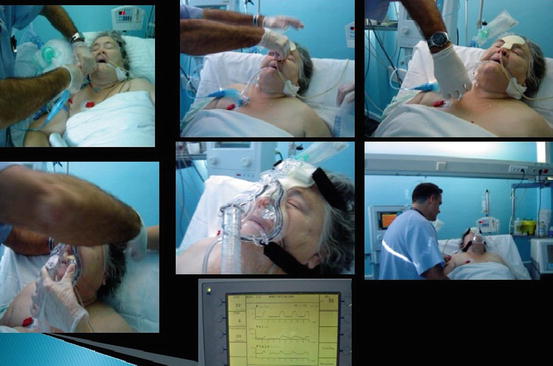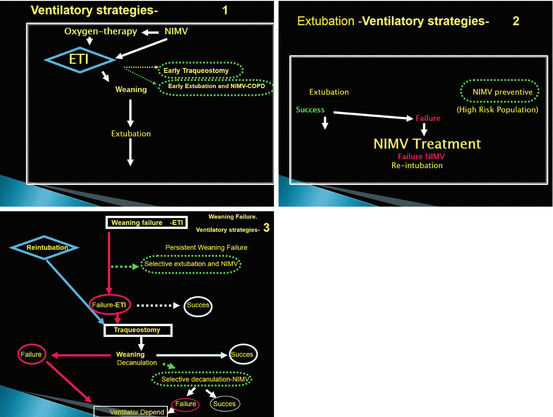Before extubation:
1. Patient selection and timing of extubation:
Age and body mass index (BMI)
Nutritional status (both over- and underweight)
Underlying diseases (cardiac and pulmonary conditions), previous use of NIV, home mechanical ventilation and CPAP (continuous positive airway pressure) use
Record and assessment of ventilator parameters, PSV pressure setting
Thorough evaluation of upper airway and assessment of potential airway difficulty
Thorough evaluation of lower airways (fluid, secretions, sputum load) and cough strength
Information regarding mechanical ventilation parameters during weaning period, i.e., airway compliance and resistance, tidal volume, minute volume, PEEP (positive end-expiratory pressure), and inspiratory oxygen fraction
Evaluation of respiratory muscle strength and endurance, evaluation of accessory muscle use
Early detection and recognition of high-risk extubation (warning signs present)a
Day 1. NIV extubation: immediate period
1. NIV setting and ventilatory mode
(a) Bilevel positive airway pressure (BiPAP)b
IPAP (inspiratory positive airway pressure) level: start at pressure equal to PS (Pressure Support) before extubation; aims are to control dyspnea, respiratory rate, and accessory muscle activity
EPAP (end–expiratory positive airway pressure) level: start at pressure equal to PEEP before extubation; aims are maintenance of adequate oxygenation and SaO2
(b) CPAP: recommended in hypoxemic respiratory failure
CPAP level: start at pressure equal to PEEP before extubation; aims are maintenance of adequate oxygenation and SaO2
2. Interface: face mask or helmet,c nasal mask, or other interface (pipe)
3. Humidification: Heated humidifiere
4. Use of complementary respiratory techniques:
Complementary techniques may be an essential aspect to the success of NIV applied either post-extubation (NIV extubation) or post decannulation (NIV decannulation). We recommend early use for at least 3 days before extubation to ensure airway permeability and improve airway resistance and compliance before extubation.
Available devices and techniques:
(a) Mechanical insufflation–exsufflation increases cough reflex after NIV and before extubation
Useful in patients with primary neuromuscular disorders and also acquired muscular weakness due to prolonged mechanical ventilation
(b) High–frequency oscillatory devices
Improve mobilization of bronchial secretions clearance by oscillation of airflow within dependent areas of lung. We recommended application of either high-frequency chest wall oscillation or intrapulmonary percussion. The key to success with these techniques is early application at the start of weaning (PSV or T tube) and continuation until at least the later stages of withdrawal of NIV (nocturnal application only). Oscillatory device usage may be extended into the oxygen-only period (via face or nasal mask) following ICU discharge.
5. Monitoring and assessment after NIV response:
(a) Clinical parameters such as respiratory rate, dyspnea, patient comfort, Glasgow Coma Score, heart rate and hemodynamic stability, evidence of muscle fatigue, and accessory muscle usage
(b) Ventilatory parameters such as TV (tidal volumen), MV (mechanical ventilation), leakage, flow, pressure and volume curve, and patient ventilator synchronization
(c) Monitoring of mask pressure areas and vigilance for the development of skin lesions.
(d) Chest X-ray (24 h)
6. Duration of NIV: In cases where NIV is being utilized as a strategy for early IMV disconnection and the prevention of extubation failure, it is essential to use NIV continuously during the first day post-extubation (i.e., at least 24 h continuous use).
In cases where NIV is applied as a prophylactic measure following routine extubation, it should be used during the first day post-extubation for at least 18 h.
II. Day 2 of NIV – extubation
NIV disconnections and positive pressure withdrawal
(a) Aim to reduce IPAP / EPAP levels to at least 50 % of initial pressures; aim to reduce inspired oxygen fraction as tolerated by the patient
In patients with sleep-related breathing disorders or high risk of hypoventilation, we recommend nocturnal NIV application.
(b) Gradual reduction of the levels of IPAP
This is especially important in patients with moderate to severe restrictive pathology (obesity hypoventilation syndrome, kyphoscoliosis, neuromuscular disorders).
Maintain initial mask or alternate with other more comfortable interface during more stable conditions (i.e., face or helmet to nasal mask or pipe) depending on type of respiratory failure, patient comorbidities, and tolerance.

Fig. 15.1
Practical details and steps of non invasive mechanical ventilation before and after extubation. These are critical for safe and effective response
15.5 Conclusion
In summary, protocols for NIV extubation require validation in a specific scenario (extubation or decannulation, planned or accidental, preventive or therapeutic). Decisions and responses are influenced by determinant factors before extubation (e.g., lung mechanics, underlying diseases,), appropriate interaction among physicians and the respiratory team (i.e., nurses, respiratory therapists), and thorough evaluation of the factors in the failure of NIV (e.g., secretions, cough reflex, neurologic disease, and muscular weakness). In real-world practice, however, proper patient selection, weaning time (short or prolonged mechanical ventilation stages), equipment, strict monitoring, early detection of favorable or failure responses, and a goal of prevention and early treatment of possible complications are accepted as essential. Training, a multidisciplinary approach, and specific weaning units are a crucial cornerstone to successful NIV extubation. Further large prospective clinical trials are needed to evaluate respiratory and nonrespiratory determinants that influence potential impacts of NIV in prolonged mechanical ventilation and all difficult weaning scenarios. A rationale practical approach to understand how NIV may interact during weaning process is summarized in Fig. 15.2.





